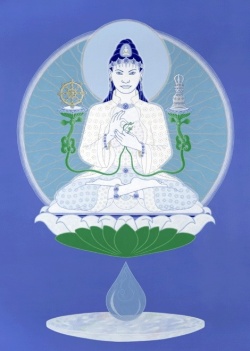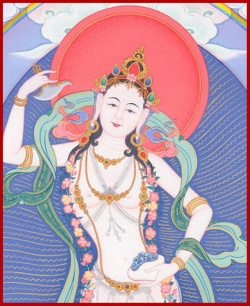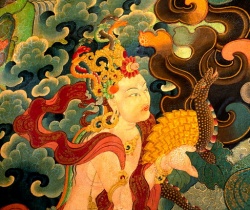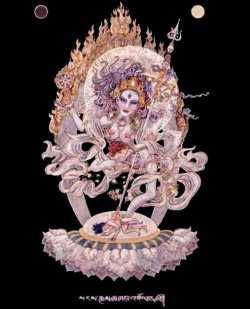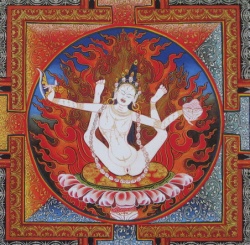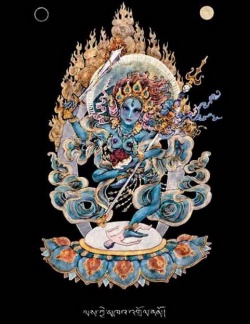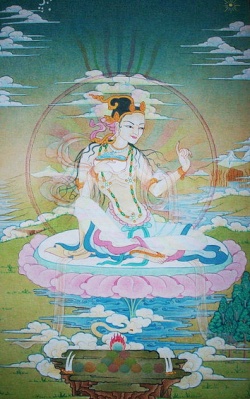Difference between revisions of "Dakini Energies in Mahamudra"
| Line 25: | Line 25: | ||
Now what I am about to speak of here is not easy to understand, but we will try to progress in a useful [[direction]]. All that is said here is [[pure]] {{Wiki|intellect}} and the internalization is very different, but [[essential]] for [[Mahamudra]] so that few can even get close, no [[matter]] what the great {{Wiki|Modern}} [[Tibetan]] salesmen try to say. | Now what I am about to speak of here is not easy to understand, but we will try to progress in a useful [[direction]]. All that is said here is [[pure]] {{Wiki|intellect}} and the internalization is very different, but [[essential]] for [[Mahamudra]] so that few can even get close, no [[matter]] what the great {{Wiki|Modern}} [[Tibetan]] salesmen try to say. | ||
| + | |||
Everyday [[life]]. | Everyday [[life]]. | ||
| + | |||
The normal day is also a [[time]] of [[constant]] Contemplation in which the [[mind]] is directed at the apparent objectives of the sixth and [[seventh grounds]] respectively. It matters not if you are working, eating, listening or answering the questions of the [[masters]]. You must still be in Contemplation. You must still be {{Wiki|aware}} in a profound way of the [[Emptiness]] of the [[Bodhisattva]] and the fact that the [[Buddha Nature]] of [[four elements]] has [[Bodhisattvahod]] as an attribute without [[form]] or no [[form]]. | The normal day is also a [[time]] of [[constant]] Contemplation in which the [[mind]] is directed at the apparent objectives of the sixth and [[seventh grounds]] respectively. It matters not if you are working, eating, listening or answering the questions of the [[masters]]. You must still be in Contemplation. You must still be {{Wiki|aware}} in a profound way of the [[Emptiness]] of the [[Bodhisattva]] and the fact that the [[Buddha Nature]] of [[four elements]] has [[Bodhisattvahod]] as an attribute without [[form]] or no [[form]]. | ||
| + | |||
In [[Chan]] it is “cold turkey”, but in [[Mahamudra]] there is assistance available. That assistance are the available [[Dakinis]]. These [[Dakinis]] are not {{Wiki|real}} in a {{Wiki|phenomenological}} [[sense]]. They are {{Wiki|real}} inasmuch as they are [[attributes]] of the [[Life Force]], just as the [[Bodhisattva]] process without the [[mind]] presence is. | In [[Chan]] it is “cold turkey”, but in [[Mahamudra]] there is assistance available. That assistance are the available [[Dakinis]]. These [[Dakinis]] are not {{Wiki|real}} in a {{Wiki|phenomenological}} [[sense]]. They are {{Wiki|real}} inasmuch as they are [[attributes]] of the [[Life Force]], just as the [[Bodhisattva]] process without the [[mind]] presence is. | ||
| − | |||
| − | [[Wisdom Dakinis]] are | + | These energies may be of a [[transcendent]] and [[spiritual]] in [[nature]], in which case they are called [[Jnana Dakinis]] ([[ye-shes kyi mkha’-‘gro-ma]]) or [[wisdom goddesses]]. Here “[[wisdom]]” or [[gnosis]] ([[jnana]], [[ye-shes]]) means [[spiritual knowledge]]. |
| + | |||
| + | [[Wisdom Dakinis]] are [[feminine manifestations of the life force]] used in the actual Contemplation {{Wiki|processes}}. | ||
| − | The second class are called [[Karma Dakinis]] ([[las kyi mkha’-‘gro-ma]]) or [[action | + | The second class are called [[Karma Dakinis]] ([[las kyi mkha’-‘gro-ma]]) or [[action goddesses]]. They are [[manifested]] subconsciously or [[consciously]] as the case may be to assist one in the maintenance of correct comportment in daily [[life]] while still maintaining the correct [[Mahamudra]] [[contemplations]]. |
Their [[forms]] are learned in the {{Wiki|cultural}} [[conditions]] in which the [[Contemplations]] are practiced and a [[Westerner]] needs to be acquanted with their [[form]] if he or she wishes to maintain the [[integrity]] of the [[Dakini]] system. Or they may be conjured up in any from primitive [[memory]]. It makes no difference if they are understood. | Their [[forms]] are learned in the {{Wiki|cultural}} [[conditions]] in which the [[Contemplations]] are practiced and a [[Westerner]] needs to be acquanted with their [[form]] if he or she wishes to maintain the [[integrity]] of the [[Dakini]] system. Or they may be conjured up in any from primitive [[memory]]. It makes no difference if they are understood. | ||
| + | |||
There are other configurations of the [[ideas]], but they are not useful to understand here when Contemplation and [[Mahamudra]] are the topic. | There are other configurations of the [[ideas]], but they are not useful to understand here when Contemplation and [[Mahamudra]] are the topic. | ||
| + | |||
The [[Karma Dakini]] appears as a [[vision]], a [[visualization]] or just an [[idea]]. They can be old and young women, [[beautiful]] or shrews, [[angry]] or delicate, but in each way they lead one to correct daily [[activities]] in any ambit so that you will not put a step wrong. They are naturally only as effective as your [[practice]] is, for {{Wiki|Identity}} itself may [[manufacture]] {{Wiki|perfect}} imitations to lead you off the track of correct Contemplation. | The [[Karma Dakini]] appears as a [[vision]], a [[visualization]] or just an [[idea]]. They can be old and young women, [[beautiful]] or shrews, [[angry]] or delicate, but in each way they lead one to correct daily [[activities]] in any ambit so that you will not put a step wrong. They are naturally only as effective as your [[practice]] is, for {{Wiki|Identity}} itself may [[manufacture]] {{Wiki|perfect}} imitations to lead you off the track of correct Contemplation. | ||
| + | |||
| + | |||
The [[Wisdom Dakinis]] are directly related to Contemplation and they are [[mental]] [[attributes]] released to help those who need them. There are five. | The [[Wisdom Dakinis]] are directly related to Contemplation and they are [[mental]] [[attributes]] released to help those who need them. There are five. | ||
| + | |||
These [[Wisdom Dakinis]] are also used and linked to the first five days in the [[bardo]], one on each successive day and each in [[inseparable]] union with one of the [[five Buddhas]]. | These [[Wisdom Dakinis]] are also used and linked to the first five days in the [[bardo]], one on each successive day and each in [[inseparable]] union with one of the [[five Buddhas]]. | ||
| + | |||
| + | |||
[[Buddha-Dakini]] [[Akashadhatvishvari]]: Her {{Wiki|color}} is white and her [[element]] {{Wiki|ether}}; she represents the [[Wisdom]] of [[Universal]] [[Law]]. | [[Buddha-Dakini]] [[Akashadhatvishvari]]: Her {{Wiki|color}} is white and her [[element]] {{Wiki|ether}}; she represents the [[Wisdom]] of [[Universal]] [[Law]]. | ||
| Line 53: | Line 64: | ||
[[Ratna-Dakini]] [[Mamaki]] whose {{Wiki|colour}} is [[yellow]] and her [[element]] [[earth]]; she represents the [[Wisdom]] of Equality. | [[Ratna-Dakini]] [[Mamaki]] whose {{Wiki|colour}} is [[yellow]] and her [[element]] [[earth]]; she represents the [[Wisdom]] of Equality. | ||
| + | |||
| + | |||
[[Padma-Dakini]] [[Pandaravasini]]: Her {{Wiki|colour}} is [[red]] and her [[element fire]]; she represents the [[Wisdom]] of Distinction & [[Discernment]]. | [[Padma-Dakini]] [[Pandaravasini]]: Her {{Wiki|colour}} is [[red]] and her [[element fire]]; she represents the [[Wisdom]] of Distinction & [[Discernment]]. | ||
[[Karma-Dakini]] [[Samayatara]] is [[green]] and her [[element]] [[air]]; she represents the [[Wisdom]] of [[Action]] & [[Accomplishment]]. | [[Karma-Dakini]] [[Samayatara]] is [[green]] and her [[element]] [[air]]; she represents the [[Wisdom]] of [[Action]] & [[Accomplishment]]. | ||
| + | |||
| + | |||
Now it is important to not get carried away with [[mental]] [[Wikipedia:concept|concepts]] and questions about {{Wiki|color}} or the [[elements]] which are not useful at the [[moment]] to the [[understanding]] of their [[function]]. | Now it is important to not get carried away with [[mental]] [[Wikipedia:concept|concepts]] and questions about {{Wiki|color}} or the [[elements]] which are not useful at the [[moment]] to the [[understanding]] of their [[function]]. | ||
| Line 63: | Line 78: | ||
The only thing important is how they are used as support in [[sixth ground]] [[Mahamudra]] [[Mahamudra]] of [[Naropa]]. | The only thing important is how they are used as support in [[sixth ground]] [[Mahamudra]] [[Mahamudra]] of [[Naropa]]. | ||
| + | |||
| + | |||
[[Buddha-Dakini]] [[Akashadhatvishvari]]: [[Wisdom]] of [[Universal]] [[Law]]. | [[Buddha-Dakini]] [[Akashadhatvishvari]]: [[Wisdom]] of [[Universal]] [[Law]]. | ||
| Line 73: | Line 90: | ||
[[Karma-Dakini]] [[Samayatara]]: [[Wisdom]] of [[Action]] & [[Accomplishment]]. | [[Karma-Dakini]] [[Samayatara]]: [[Wisdom]] of [[Action]] & [[Accomplishment]]. | ||
| + | |||
| + | |||
Now these [[Dakinis]] are used in Contemplation together at the [[Mahamudra]] level with their [[Consort]]. | Now these [[Dakinis]] are used in Contemplation together at the [[Mahamudra]] level with their [[Consort]]. | ||
Since there is no [[intention]] in this course to lead you into the details of the Contemplation [[practice]] and how to use these [[dakinis]] we will discuss just one in a general way without any details which will assist you in making a fool of yourself. | Since there is no [[intention]] in this course to lead you into the details of the Contemplation [[practice]] and how to use these [[dakinis]] we will discuss just one in a general way without any details which will assist you in making a fool of yourself. | ||
| + | |||
| + | |||
We will take the [[Vajra Dakini]] of [[Mirror wisdom]]… She is the Daini that will represent the [[power]] that will lift one out of [[Conceptualization]] and [[Perception]] by destroying before they begin all obstructions related to that. [[Thus]] the [[practitioner]] has free access to the [[Emptiness]] of [[Emptiness]] without {{Wiki|Distraction}}. | We will take the [[Vajra Dakini]] of [[Mirror wisdom]]… She is the Daini that will represent the [[power]] that will lift one out of [[Conceptualization]] and [[Perception]] by destroying before they begin all obstructions related to that. [[Thus]] the [[practitioner]] has free access to the [[Emptiness]] of [[Emptiness]] without {{Wiki|Distraction}}. | ||
| + | |||
| + | |||
You will remember that Contemplation requires the [[clear comprehension]] at a profound level of the [[Emptiness]] of [[Bodhisattvahood]]. Without both, access to the [[seventh ground]] by way of the sixth is impossible. | You will remember that Contemplation requires the [[clear comprehension]] at a profound level of the [[Emptiness]] of [[Bodhisattvahood]]. Without both, access to the [[seventh ground]] by way of the sixth is impossible. | ||
Now we are close to a secret. The [[Dakini]] represents the [[power]] that resists the enemies of the [[conscious mind]] that inhibits the [[Wisdom]] of [[Existence]], the [[knowledge]] of the [[Emptiness]] of [[Emptiness]]. That is one [[element]]. | Now we are close to a secret. The [[Dakini]] represents the [[power]] that resists the enemies of the [[conscious mind]] that inhibits the [[Wisdom]] of [[Existence]], the [[knowledge]] of the [[Emptiness]] of [[Emptiness]]. That is one [[element]]. | ||
| + | |||
| + | |||
How do we enjoin this with the [[Emptiness]] of [[Bodhisattvahood]]? | How do we enjoin this with the [[Emptiness]] of [[Bodhisattvahood]]? | ||
| + | |||
| + | |||
We use her [[consort]]... [[Heruka]]. Who is he? He is the [[wisdom]] of [[Compassion]] in the Unity of all things. He is the antagonist of all that inhibits that [[wisdom]] in the [[human]] creature. He protects the [[wisdom]] of the [[Life Force]]. He protects the [[Wisdom]] of [[Bodhisattvahood]]. | We use her [[consort]]... [[Heruka]]. Who is he? He is the [[wisdom]] of [[Compassion]] in the Unity of all things. He is the antagonist of all that inhibits that [[wisdom]] in the [[human]] creature. He protects the [[wisdom]] of the [[Life Force]]. He protects the [[Wisdom]] of [[Bodhisattvahood]]. | ||
| + | |||
| + | |||
That [[wisdom]] is the [[Wisdom]] of the [[Emptiness]] of [[Bodhisattvahood]], the destruction of the [[conceptualization]] and [[perception]] of Bodhisattvhood. | That [[wisdom]] is the [[Wisdom]] of the [[Emptiness]] of [[Bodhisattvahood]], the destruction of the [[conceptualization]] and [[perception]] of Bodhisattvhood. | ||
So what do we do in the Contemplation, using this aid? We bring [[Vajrayogini]] and [[Heruka]] together in Union. Then we remain in that union correcly until they dissolve and permit entry into the [[seventh ground]] Contemplation. | So what do we do in the Contemplation, using this aid? We bring [[Vajrayogini]] and [[Heruka]] together in Union. Then we remain in that union correcly until they dissolve and permit entry into the [[seventh ground]] Contemplation. | ||
| + | |||
| + | |||
A magnificent aide for those who need that assistance, but a [[foolish]] [[practice]] for those who can do so directly without [[visualization]] assistance. | A magnificent aide for those who need that assistance, but a [[foolish]] [[practice]] for those who can do so directly without [[visualization]] assistance. | ||
Now you know how it functions in [[Mahamudra]]. One day if you are ready we will dicuss how to convert {{Wiki|theory}} into [[practice]]. Those in [[Chan]] at the [[moment]] investigating [[Zongmi’s]] practices will see the resemblance to the [[Emptiness]] of [[Emptiness]] practices. | Now you know how it functions in [[Mahamudra]]. One day if you are ready we will dicuss how to convert {{Wiki|theory}} into [[practice]]. Those in [[Chan]] at the [[moment]] investigating [[Zongmi’s]] practices will see the resemblance to the [[Emptiness]] of [[Emptiness]] practices. | ||
| + | |||
| + | |||
Who should do these practices? | Who should do these practices? | ||
| + | |||
| + | |||
My [[experience]] tells me that the [[East Mountain]] [[Ch’an]] [[practice]] is most effective for those who were confused and now more [[sensitive]], who have developed an [[affinity]] for the [[Grasping]] of [[Samsara]]. | My [[experience]] tells me that the [[East Mountain]] [[Ch’an]] [[practice]] is most effective for those who were confused and now more [[sensitive]], who have developed an [[affinity]] for the [[Grasping]] of [[Samsara]]. | ||
| Line 105: | Line 140: | ||
Just for diversion I give you [[Drukpa]] Kunley's account of the [[Dakinis]] that he generated, as he envisioned them. He is talking to several young girls at the [[time]]. | Just for diversion I give you [[Drukpa]] Kunley's account of the [[Dakinis]] that he generated, as he envisioned them. He is talking to several young girls at the [[time]]. | ||
| + | |||
| + | |||
'The [[Wisdom Dakini]] is fair, flushed and radiant,' the [[Lama]] told them. 'She has five white moles across her [[hair]] line, and she is [[compassionate]], [[pure]], [[virtuous]], and devout. Also, her [[body]] is shapely. Coupling with her brings [[happiness]] in this [[life]], and prevents any fall into [[hell]] in the next. | 'The [[Wisdom Dakini]] is fair, flushed and radiant,' the [[Lama]] told them. 'She has five white moles across her [[hair]] line, and she is [[compassionate]], [[pure]], [[virtuous]], and devout. Also, her [[body]] is shapely. Coupling with her brings [[happiness]] in this [[life]], and prevents any fall into [[hell]] in the next. | ||
| Line 111: | Line 148: | ||
The [[Diamond]] [[Dakini]] is fair with a well-filled supple [[body]]. She has long [[eyebrows]], a [[sweet]] {{Wiki|voice}}, and enjoys singing and [[dancing]]. Coupling with her brings [[success]] in this [[life]] and [[rebirth]] as a [[god]]. | The [[Diamond]] [[Dakini]] is fair with a well-filled supple [[body]]. She has long [[eyebrows]], a [[sweet]] {{Wiki|voice}}, and enjoys singing and [[dancing]]. Coupling with her brings [[success]] in this [[life]] and [[rebirth]] as a [[god]]. | ||
| + | |||
| + | |||
The [[Jewel Dakini]] has a pretty white face with a [[pleasant]] [[yellow]] tinge to it. Her [[body]] is slender, and she is tall. Her [[hair]] is white, and she has little vanity and a very slender waist line. Coupling with her gives one [[wealth]] in this [[life]], and shuts the gates of [[hell]]. | The [[Jewel Dakini]] has a pretty white face with a [[pleasant]] [[yellow]] tinge to it. Her [[body]] is slender, and she is tall. Her [[hair]] is white, and she has little vanity and a very slender waist line. Coupling with her gives one [[wealth]] in this [[life]], and shuts the gates of [[hell]]. | ||
| Line 117: | Line 156: | ||
The [[Action]] [[Dakini]] has a radiant blue {{Wiki|skin}} with a brownish hue, and a broad {{Wiki|forehead}}. She is rather sadistic. Coupling with her is a defense against enemies, and closes the gates to the [[lower realms]]. | The [[Action]] [[Dakini]] has a radiant blue {{Wiki|skin}} with a brownish hue, and a broad {{Wiki|forehead}}. She is rather sadistic. Coupling with her is a defense against enemies, and closes the gates to the [[lower realms]]. | ||
| + | |||
| + | |||
The [[Worldly Dakini]] has a white, smiling, and radiant face, and she is respectful to her [[parents]] and friends. She is trustworthy and a generous spender. Coupling with her assures one of the {{Wiki|continuance}} of the [[family]] line, generates [[food]] and [[wealth]], and assures one of [[rebirth]] as a [[human being]]. | The [[Worldly Dakini]] has a white, smiling, and radiant face, and she is respectful to her [[parents]] and friends. She is trustworthy and a generous spender. Coupling with her assures one of the {{Wiki|continuance}} of the [[family]] line, generates [[food]] and [[wealth]], and assures one of [[rebirth]] as a [[human being]]. | ||
| Line 123: | Line 164: | ||
The Ashen [[Dakini]] has [[yellow]] flesh which has an ashen complexion and a spongy {{Wiki|texture}}. She eats ashes from the grate. Coupling with her [[causes]] much [[suffering]] and enervation, and [[rebirth]] as a [[hungry ghost]].' | The Ashen [[Dakini]] has [[yellow]] flesh which has an ashen complexion and a spongy {{Wiki|texture}}. She eats ashes from the grate. Coupling with her [[causes]] much [[suffering]] and enervation, and [[rebirth]] as a [[hungry ghost]].' | ||
| + | |||
| + | |||
'What kind of [[Dakinis]] are we?' asked the girls eagerly. | 'What kind of [[Dakinis]] are we?' asked the girls eagerly. | ||
| Line 129: | Line 172: | ||
'What type?' they insisted. | 'What type?' they insisted. | ||
| + | |||
| + | |||
'You are [[greedy]] but poor, and sexually frustrated but friendless. Even if you do find some idiot to couple with you, no one will gain anything from it.' | 'You are [[greedy]] but poor, and sexually frustrated but friendless. Even if you do find some idiot to couple with you, no one will gain anything from it.' | ||
Latest revision as of 07:54, 25 December 2023
We said that the two means to encounter the Essence are:
- Direct seventh ground access with complete internalization of the Emptiness of Bodhisattvahood.
- Direct sixth ground access with complete internalization of the emptiness of Bodhisattvahood together with necessary Contemplation (not concentration) upon the Emptiness of Emptiness. This is an approach of no conceptualization and no perception.
Now in the sixth ground that I have presented is the bare bone path in Dao and Chan.
In Mahamudra one may enter in precisely the same way as with Chan. The seventh ground entry is called the Chan of the Tathagatas and the sixth ground entry is the Chan of East Mountain.
In Mahamudra in order to differentiate, let us call the Mahamudra seventh ground entry as the Contemplation of Tilopa in honour of that great Master. Let us call the sixth ground entry in honour of his student the Contemplation of Naropa.
In Mahamudra the sixth ground may be accompanied by an additional aid. She is called Vajra Yogini and she is accompanied by Heruka, her consort.
Now what I am about to speak of here is not easy to understand, but we will try to progress in a useful direction. All that is said here is pure intellect and the internalization is very different, but essential for Mahamudra so that few can even get close, no matter what the great Modern Tibetan salesmen try to say.
Everyday life.
The normal day is also a time of constant Contemplation in which the mind is directed at the apparent objectives of the sixth and seventh grounds respectively. It matters not if you are working, eating, listening or answering the questions of the masters. You must still be in Contemplation. You must still be aware in a profound way of the Emptiness of the Bodhisattva and the fact that the Buddha Nature of four elements has Bodhisattvahod as an attribute without form or no form.
In Chan it is “cold turkey”, but in Mahamudra there is assistance available. That assistance are the available Dakinis. These Dakinis are not real in a phenomenological sense. They are real inasmuch as they are attributes of the Life Force, just as the Bodhisattva process without the mind presence is.
These energies may be of a transcendent and spiritual in nature, in which case they are called Jnana Dakinis (ye-shes kyi mkha’-‘gro-ma) or wisdom goddesses. Here “wisdom” or gnosis (jnana, ye-shes) means spiritual knowledge.
Wisdom Dakinis are feminine manifestations of the life force used in the actual Contemplation processes.
The second class are called Karma Dakinis (las kyi mkha’-‘gro-ma) or action goddesses. They are manifested subconsciously or consciously as the case may be to assist one in the maintenance of correct comportment in daily life while still maintaining the correct Mahamudra contemplations.
Their forms are learned in the cultural conditions in which the Contemplations are practiced and a Westerner needs to be acquanted with their form if he or she wishes to maintain the integrity of the Dakini system. Or they may be conjured up in any from primitive memory. It makes no difference if they are understood.
There are other configurations of the ideas, but they are not useful to understand here when Contemplation and Mahamudra are the topic.
The Karma Dakini appears as a vision, a visualization or just an idea. They can be old and young women, beautiful or shrews, angry or delicate, but in each way they lead one to correct daily activities in any ambit so that you will not put a step wrong. They are naturally only as effective as your practice is, for Identity itself may manufacture perfect imitations to lead you off the track of correct Contemplation.
The Wisdom Dakinis are directly related to Contemplation and they are mental attributes released to help those who need them. There are five.
These Wisdom Dakinis are also used and linked to the first five days in the bardo, one on each successive day and each in inseparable union with one of the five Buddhas.
Buddha-Dakini Akashadhatvishvari: Her color is white and her element ether; she represents the Wisdom of Universal Law.
Vajra-Dakini represents the Wisdom of the Mirror. Her colour is blue and her element water.
Ratna-Dakini Mamaki whose colour is yellow and her element earth; she represents the Wisdom of Equality.
Padma-Dakini Pandaravasini: Her colour is red and her element fire; she represents the Wisdom of Distinction & Discernment.
Karma-Dakini Samayatara is green and her element air; she represents the Wisdom of Action & Accomplishment.
Now it is important to not get carried away with mental concepts and questions about color or the elements which are not useful at the moment to the understanding of their function.
Different traditions give them different colors. Vajrayogini, for example, is often generated with a red form.
The only thing important is how they are used as support in sixth ground Mahamudra Mahamudra of Naropa.
Buddha-Dakini Akashadhatvishvari: Wisdom of Universal Law.
Vajra-Dakini : Mirror Wisdom
Ratna-Dakini: the Wisdom of Equality.
Padma-Dakini Pandaravasini: Wisdom of Distinction & Discernment.
Karma-Dakini Samayatara: Wisdom of Action & Accomplishment.
Now these Dakinis are used in Contemplation together at the Mahamudra level with their Consort.
Since there is no intention in this course to lead you into the details of the Contemplation practice and how to use these dakinis we will discuss just one in a general way without any details which will assist you in making a fool of yourself.
We will take the Vajra Dakini of Mirror wisdom… She is the Daini that will represent the power that will lift one out of Conceptualization and Perception by destroying before they begin all obstructions related to that. Thus the practitioner has free access to the Emptiness of Emptiness without Distraction.
You will remember that Contemplation requires the clear comprehension at a profound level of the Emptiness of Bodhisattvahood. Without both, access to the seventh ground by way of the sixth is impossible.
Now we are close to a secret. The Dakini represents the power that resists the enemies of the conscious mind that inhibits the Wisdom of Existence, the knowledge of the Emptiness of Emptiness. That is one element.
How do we enjoin this with the Emptiness of Bodhisattvahood?
We use her consort... Heruka. Who is he? He is the wisdom of Compassion in the Unity of all things. He is the antagonist of all that inhibits that wisdom in the human creature. He protects the wisdom of the Life Force. He protects the Wisdom of Bodhisattvahood.
That wisdom is the Wisdom of the Emptiness of Bodhisattvahood, the destruction of the conceptualization and perception of Bodhisattvhood.
So what do we do in the Contemplation, using this aid? We bring Vajrayogini and Heruka together in Union. Then we remain in that union correcly until they dissolve and permit entry into the seventh ground Contemplation.
A magnificent aide for those who need that assistance, but a foolish practice for those who can do so directly without visualization assistance.
Now you know how it functions in Mahamudra. One day if you are ready we will dicuss how to convert theory into practice. Those in Chan at the moment investigating Zongmi’s practices will see the resemblance to the Emptiness of Emptiness practices.
Who should do these practices?
My experience tells me that the East Mountain Ch’an practice is most effective for those who were confused and now more sensitive, who have developed an affinity for the Grasping of Samsara.
I believe that those who were Grasping with a Samsaric veneer of sensitivity, if the more direct approach is difficult in Mahamudra or Chan for such a person, may be advised to use Vajrayogini. But beware, it is not an easy way, for there are many pitfalls. Without a good master and constant interpersonal interaction there will be no encounter with Awakening.
A DIVERSION
Just for diversion I give you Drukpa Kunley's account of the Dakinis that he generated, as he envisioned them. He is talking to several young girls at the time.
'The Wisdom Dakini is fair, flushed and radiant,' the Lama told them. 'She has five white moles across her hair line, and she is compassionate, pure, virtuous, and devout. Also, her body is shapely. Coupling with her brings happiness in this life, and prevents any fall into hell in the next.
The Buddha Dakini has a bluish complexion and a radiant smile. She has little lust, is long-lived, and bears many sons. Coupling with her bestows longevity and a rebirth in the Orgyen Paradise
The Diamond Dakini is fair with a well-filled supple body. She has long eyebrows, a sweet voice, and enjoys singing and dancing. Coupling with her brings success in this life and rebirth as a god.
The Jewel Dakini has a pretty white face with a pleasant yellow tinge to it. Her body is slender, and she is tall. Her hair is white, and she has little vanity and a very slender waist line. Coupling with her gives one wealth in this life, and shuts the gates of hell.
The Lotus Dakini has a bright pink skin, an oily complexion, a short body and limbs, and wide hips. She is lustful and garrulous. Coupling with her generates many sons, while gods, demons and men are controlled, and the gates to the lower realms are closed.
The Action Dakini has a radiant blue skin with a brownish hue, and a broad forehead. She is rather sadistic. Coupling with her is a defense against enemies, and closes the gates to the lower realms.
The Worldly Dakini has a white, smiling, and radiant face, and she is respectful to her parents and friends. She is trustworthy and a generous spender. Coupling with her assures one of the continuance of the family line, generates food and wealth, and assures one of rebirth as a human being.
The Flesh-Eating Dakini has a dark and ashen complexion, a wide mouth with protruding fangs, a trace of a third eye upon her forehead, long claw-like finger nails, and a black heart in her vagina. She delights in eating meat, and she devours the children that she bears. Also, she is an insomniac. Coupling with her induces a short life, much disease, little enjoyment of wealth in this life, and rebirth in the deepest hell.
The Ashen Dakini has yellow flesh which has an ashen complexion and a spongy texture. She eats ashes from the grate. Coupling with her causes much suffering and enervation, and rebirth as a hungry ghost.'
'What kind of Dakinis are we?' asked the girls eagerly.
'You are a rather different kind,' replied the Lama.
'What type?' they insisted.
'You are greedy but poor, and sexually frustrated but friendless. Even if you do find some idiot to couple with you, no one will gain anything from it.'
